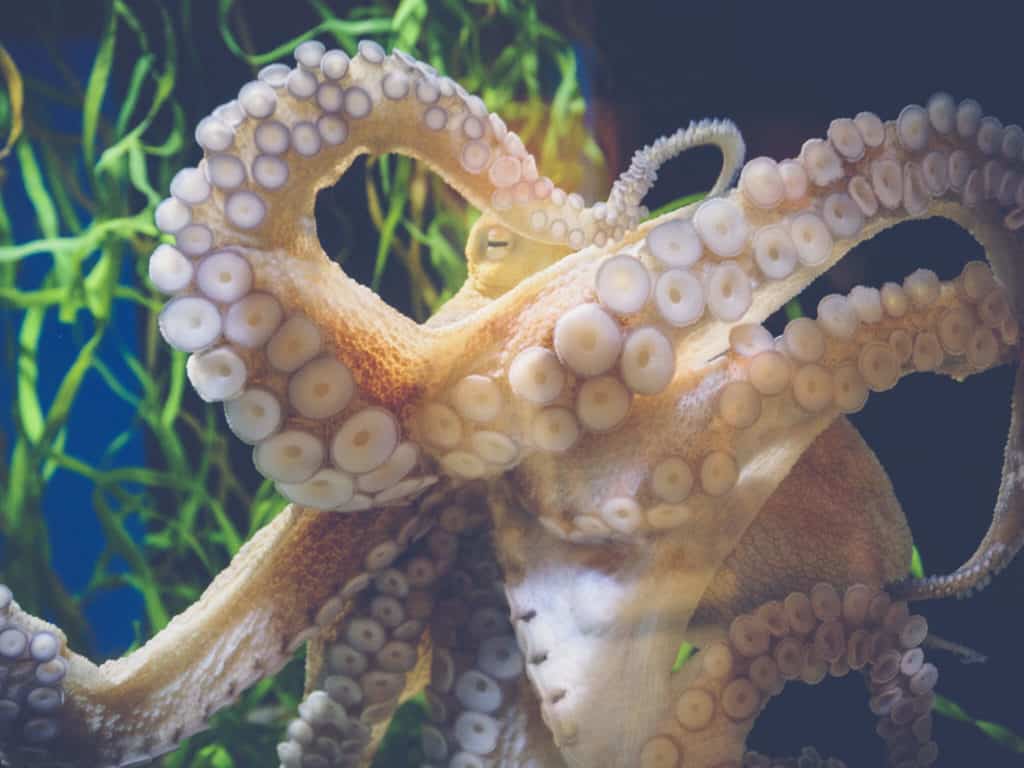Octopuses can be found in all of the world’s oceans, often roaming around in search of prey such as clams, sea stars, crabs, and much more.
These incredibly intelligent animals have larger brains for their body size than all animals except birds and mammals.
Octopuses are capable of problem-solving, and squeezing into incredibly tight spaces and new research has found that they are about as intelligent as the average dog.
Intelligence aside, today we’re going to take a closer look at the appendages of an Octopus, which is what they are most known for, as well as answer a question many of our readers are searching for.
Do Octopuses have tentacles?
Yes, but technically they have arms. Octopuses have eight tentacles that divide up into six “arms” and two “legs”. In fact, they are not really tentacles at all, as there is a difference between tentacles and arms that you may not be aware of.
Do Octopus Have Tentacles Or Arms?
An Octopus has eight appendages which is what gives them that famous alien-like appearance that many find so frightening.
Each of which has rows of suckers running down its length. But these are not tentacles as you may expect, and in strict anatomical terms, they are arms.
Sea Life biologist Oliver Walenciak said, “one can assume that the front six tentacles have the function of arms and that the back two take over the function of legs.”
However, unlike humans or some other animals, most Octopuses did not appear to be left or right-handed.
What Is The Difference Between Arms And Tentacles?
The main difference between arms and tentacles is that arms, like those of an octopus, have suction cups the entire length of the limb.
Whereas tentacles only have suction cups near the end of the limb. Some cephalopods have arms, whilst some have tentacles, and some even have both.
Cephalopod tentacles and arms lack bones; instead, they are built from an intricate tapestry of coiling muscle fibers.
A cuttlefish shoots a tentacle at its prey by contracting fibers along the tentacle’s entire length. By contracting only some fibers, an octopus can work its arms into a tiyn recess or unscrew a lid.
This makes them exceptional at squeezing into small spaces, as they’ll often squeeze through crab pots to steal a fisherman’s catch.
Why Do Octopus Need Arms?
Being equipped with eight sucker-covered arms is a huge advantage for octopuses. It enables them to walk, grab prey, hang onto surfaces, and even taste through a sense known as chemotactile sensations.
They use their arms every single day for survival, allowing them to grip onto prey to stop them from escaping which is essential for them to eat food.
Octopus tentacles are incredibly strong and powerful tools that not only help them to catch prey but also fend off predators too.
Their arms are long and strong enough to wrap around other animals whilst the suckers help them to adhere to their shells or flesh.
Do All Octopus Have Eight Tentacles?
Yes, octopuses have eight tentacles with two rows of suction cups extending the full length of each arm.
The arms then come together at a centralized mouth with a hard parrot-like beak.
Male and female octopuses both have the same number of tentacles, but males have one arm that is slightly different and is designed to hold and deposit sperm packets into the female octopus.
Final Thoughts
So, do octopuses have tentacles? Yes, but technically they are arms as they are different from tentacles that only have suction cups near the end of the appendage.
Octopus tentacles are still well known as being tentacles, but to be strict and anatomical these are defined as arms.
They are broken down into six arms and two legs, which help the octopus to navigate its surroundings and also hunt prey.
Hopefully, you’ve learned something new in this post today about octopus tentacles and why they are not really tentacles as such.
Thanks for taking the time to read this post and feel free to stick around to learn more about octopuses and lots of other fascinating marine life.

Hi, I’m George – the founder of MarinePatch. I created this blog as marine wildlife has been my passion for many years. I’ve spent over a decade in the marine wildlife industry and spent years out in the field conducting research. In today’s modern world, an online blog is the best place for me to share my findings and reach as many people as possible to help educate and inspire others. Enjoy your time here and you’re welcome back anytime!

